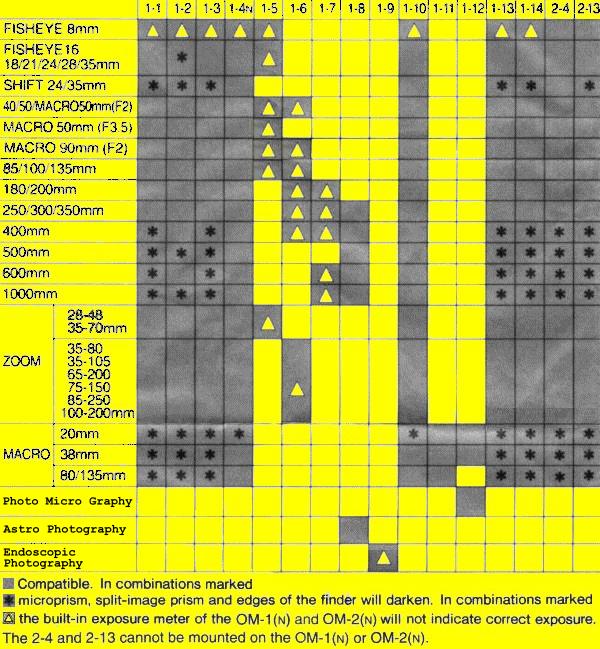
Finder Group Focusing Screens

Summary |
Main Characteristics |
Notes - Related Units |
| A choice of 17 interchangeable focusing screens is available. To obtain the optimum viewfinder image in every photographic situation, interchangeable focusing screens are indispensable to a true system camera. | A full range of focusing screens insures the best image rendition with
lenses of every focal length. With the pentaprism fixed, the screens are changed through the lens mount insuring insuring a high degree of protection against dust and dirt. |
Only the single digit OM System Cameras [OM-1(n), OM-2(n,Sp), OM-3(Ti)
and OM-4(Ti)] have interchangeable focusing screens. The Focusing Screens 1 can be mounted in all of these cameras. The Focusing Screens 2 can only be mounted in the OM-2Sp, OM-3(Ti) and OM-4(Ti). The screen must be handled with great care. Marring the screen and mirror with fingerprints and smudge, and wiping with solvent should be avoided absolutely. The clear-field type focusing screens provide brighter viewfinder images. However, with the OM-1(n) or OM-2(n) the needle on manual does not give correct light readings. With the OM-2(n) on Auto the needle does not point to the precise shutter speed but correct exposures are made on the film. With the OM-2Sp, OM-3(Ti) or OM-4(Ti) the clear-field type focusing screens give correct light readings. |
Type |
Picture |
Applications |
Focusing |
Notes |
1-1 |
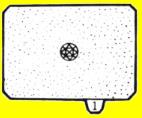 |
Standard type focusing screen, suitable for general photography. | Fast and accurate focusing is done on the central microprism spot as well
as on the surrounding matte area. The subject is in focus when the jagged pattern of the microprism spot disappears and the spot becomes crisp and clear. |
When a lens with a maximum speed of F5.6 or slower is used, the
microprism darkens and the focusing must be made on the matte area. The meter needle gives correct light readings1. |
| 1-2 Microprism-matte type (for standard & telephoto lenses) |
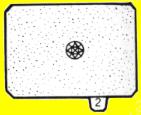 |
Suitable for general photography in conjunction with a standard or telephoto lens. | Focusing is done on the central microprism spot as well as on the surrounding matte area. | When a lens with a maximum speed of F8 or slower is used, the microprism
darkens and the focusing must be made on the matte area. The meter needle gives correct light readings1. |
| 1-3 Split image-matte type (for most lenses) |
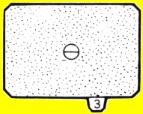 |
Suitable for general photography ensuring critical focusing, and ideal for photographers who prefer the split-field and coincidence type focusing; particulary advantageous when taking a subject with vertical lines. | Focusing is done easily by aligning the split lines. | When a lens ith a maximum speed of F5.6 or slower is used, the split
prism darkens and the focusing must be made on the matte area. The meter needle gives correct light readings1. |
| 1-4 All matte type (for most lenses) |
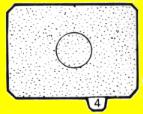 |
Suitable for general photography and ideal for photographers who prefer a
clear-cut view field free from microprism or split prism and for those who are accustomed
to focus using matte area. Also suitable for super telephotography as well as close-up photography in conjunction with macro lenses and Auto Bellows. |
For easy focusing the matte surface is ground rough. The subject is in focus when the image is sharp. | The large central circle is slightly finer matted, which
can be helpful with macro photography and in low light conditions. It can
also be used to roughly indicate the center-weighted
metering area of the OM-1(n) and OM-2(n). The meter needle gives correct light readings1. |
| 1-4n All matte type (for most lenses) |
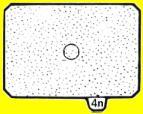 |
Suitable for general photography and ideal for photographers who prefer a
clear-cut view field free from microprism or split prism and for those who are accustomed
to focus using matte area. Also suitable for super telephotography as well as close-up photography in conjunction with macro lenses and Auto Bellows. |
Focusing is done on the matte area. | The small central circle corresponds to the 2% spot metering area of the
OM-2Sp, OM-3(Ti) and OM-4(Ti). The meter needle gives correct light readings1. |
| 1-5 Microprism-clear field type (for wide angle & standard lenses) |
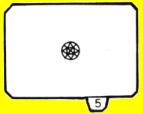 |
This transparent screen provides an exceptionally bright finder image. Highly suitable for snapshots using wide angle and standard lenses. | Focusing is done on the central microprism spot. | The lack of a matte surface means depth-of-field effects cannot be
ascertained.. The meter needle does not give correct light readings1. |
| 1-6 Microprism-clear field type (for standard & telephoto lenses) |
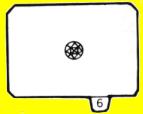 |
This screen is compatible with standard and telephoto lenses and provides an exceptionally bright finder image. | Focusing is done on the central microprism spot. | The lack of a matte surface means depth-of-field effects cannot be
ascertained.. The meter needle does not give correct light readings1. |
| 1-7 Microprism-clear field type (for super telephoto lenses) |
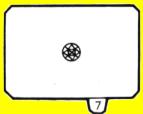 |
Developed primarly for use with super telephoto lenses, this clear screen provides an extremely bright finder image. The microprism spot remains bright even with a lens whose maximum speed is F11, so that this screen is ideal for use with super telephoto lenses with slow lens speeds. | Focusing is done on the central microprism spot. | The lack of a matte surface means depth-of-field effects cannot be
ascertained.. The meter needle does not give correct light readings1. |
| 1-8 All matte type (for super telephoto lenses & astronomical telescopes) |
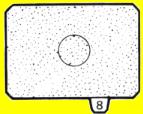 |
This screen is ideal for use with super telephoto lenses of 300mm or more
in focal length, or for astrophotography. The extreme fineness of the matte surface permits outstanding field definition. |
Focusing is done on the matte area. More accurate focusing may be achieved by the use of the Varimagni Finder. |
When used with astronomical telescopes, bright images of celestial bodies
are obtained both in direct objective and indirect magnified astrophotography. The meter needle gives correct light readings1. |
| 1-9 Clear field type (for endoscopic photography) |
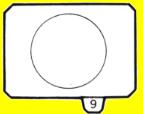 |
Designed especially for use with the Olympus endoscopes. The transparent condenser type screen has a central 23mm diameter convex surface and no surrounding fresnel lens. | Requires no focusing when the OM-1 is attached to the endoscope by means of the OM Endoscope Adapter. | This screen can only be used with an endoscope. Auto-exposure is made by Olympus light supply linked to the endoscope. |
| 1-10 Checker-matte type (for shift lenses) |
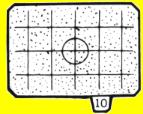 |
This screen was specially designed for use with the Zuiko Shift Lenses.
The grid lines engraved on the all-matte ground screen (the same as the 1-4) is used for
vertical and horizontal picture alignment in architectural and composite panoramic
photography. The screen is also suitable for general photography, super telephotography and close-up / macrophotography in conjuction with the macro lenses and Auto Bellows. |
Focusing is done on the matte area. | The meter needle gives correct light readings1. |
| 1-11 Cross hairs-matte type (for close-up & macrophotography) |
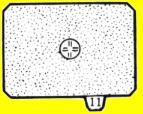 |
This screen has a cross hairs spot surrounded by a finely ground matte area and is highly advantageous for close-up and macrophotography in conjunction with Auto Bellows or extension tubes. | For focusing in low magnification close-up photography, use the matte area, and in greater than life size macrophotography use the double cross hairs in the same way as with the 1-12 Focusing Screen. | The meter needle gives correct light readings1, but depending on the condition of the specimen, the reading must be compensated for (e.g. black dots against white background). |
| 1-12 Cross hairs-clear field type (for photomicrography & greater than life size macrophotography) |
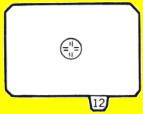 |
This transparent screen offers the photographer focusing with an unusually bright finder image. Ideal for macrophotography of 1:1 or over, and for photomicrography. | To focus, first correct your diopter using a dioptric correction lens or Varimagni Finder2 so that each line of the double cross hairs can be seen clearly and separately. Then bring the specimen into focus. | The meter needle gives correct light readings1, but depending on the condition of the specimen, the reading must be compensated for. |
| 1-13 Microprism/split image-matte type (for most lenses) |
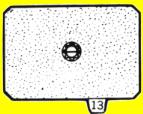 |
Most suitable for normal photography, this screen assures pinpoint focusing. The central split-image rangefinder is encircled by a microprism collar. Since the outer area has a matte surface, the screen can be used in the same way as the standard 1-1 and 1-3 screens. | Align the split vertical lines of the subject image, or focus on he microprism or matte area. | When a lens ith a maximum speed of F5.6 or slower is used, the prism
darkens and the focusing must be made on the matte area. The meter needle gives correct light readings1. |
| 1-14 Microprism/split image-matte type (for most lenses) |
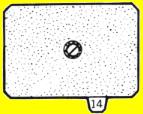 |
Most suitable for normal photography. The central split-image rangefinder, encircled by a microprism collar, is inclined 45 degrees to allow easy focusing on subjects with vertical or horizontal lines. | Align the split vertical lines of the subject image, or focus on he microprism or matte area. | When a lens ith a maximum speed of F5.6 or slower is used, the prism
darkens and the focusing must be made on the matte area. The meter needle gives correct light readings1. |
| 2-4 All matte type (for most lenses) |
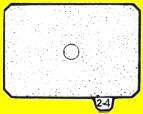 |
This Fine Lumi-Micron screen provides a very bright finder image. Suitable for general photography and ideal for photographers who prefer a clear-cut view field free from microprism or split prism and for those who are accustomed to focus using matte area. Also suitable for super telephotography as well as close-up photography in conjunction with macro lenses and Auto Bellows. |
Focusing is done on the matte area. | This screen can't be used in an OM-1(n) or OM-2(n). |
| 2-13 Microprism/split image-matte type (for most lenses) |
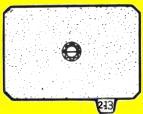 |
This Fine Lumi-Micron screen provides a very bright finder image. Most suitable for normal photography, this screen assures pinpoint focusing. The central split-image rangefinder is encircled by a microprism collar. |
Align the split vertical lines of the subject image, or focus on he microprism or matte area. | This screen can't be used in an OM-1(n) or OM-2(n). When a lens ith a maximum speed of F5.6 or slower is used, the prism darkens and the focusing must be made on the matte area. |
1 Applies to the OM-1(n) and OM-2(n). Meter readings with this screen on the
OM-2Sp, OM-3(Ti) and OM-4(Ti) are correct. Auto "OTF" exposure with the OM-2(n)
will be correct even with incorrect meter readings.
2 Or the built-in diopter correction of the OM-3(Ti), OM-4(Ti).
Compatible focusing screens
